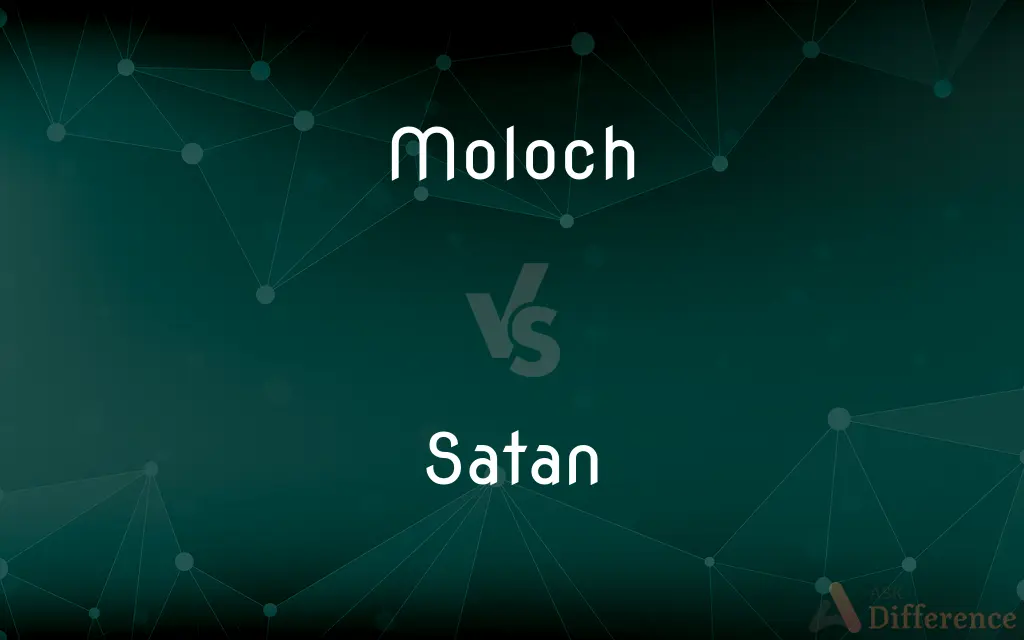Moloch vs. Satan — What's the Difference?
Edited by Tayyaba Rehman — By Fiza Rafique — Updated on March 30, 2024
Moloch represents child sacrifice in ancient rites, while Satan embodies evil in Abrahamic religions.

Difference Between Moloch and Satan
Table of Contents
ADVERTISEMENT
Key Differences
Moloch is often associated with the ancient Canaanite religion and is depicted as a god to whom child sacrifices were made. In contrast, Satan is a figure representing the embodiment of evil and the adversary of God in Abrahamic religions, including Judaism, Christianity, and Islam.
While Moloch's worship is characterized by the specific act of child sacrifice to gain favor or appease the deity, Satan is not linked to any single form of worship or ritual. Instead, Satan tempts, opposes, and tests the faith of humans, seeking to lead them away from righteousness.
The historical context of Moloch is rooted in specific ancient cultures and their practices, which have largely disappeared or been absorbed into other religious traditions. On the other hand, the concept of Satan has evolved and adapted over centuries, remaining a central figure in the theology and mythology of multiple religions.
Moloch's role and significance are primarily historical and of interest to scholars of ancient religions and cultures. Conversely, Satan plays an active role in the religious life and moral decisions of believers in contemporary societies, symbolizing the ongoing struggle between good and evil.
Lastly, interpretations of Moloch are relatively uniform, with the deity consistently associated with child sacrifice. In contrast, views on Satan vary significantly across different religions and denominations, ranging from a literal being to a symbolic representation of sin or the human propensity for evil.
ADVERTISEMENT
Comparison Chart
Representation
Ancient god associated with child sacrifice.
Embodiment of evil and adversary of God in Abrahamic religions.
Worship Practices
Child sacrifices to gain favor or appease.
Temptation, opposition, and testing of faith, without specific rituals of worship.
Historical Context
Specific to ancient Canaanite and related cultures.
Central in Abrahamic religions, with evolving interpretations across history.
Role in Religion
Historical interest, associated with ancient practices.
Active moral adversary in contemporary religious belief, symbolizing evil.
Interpretations
Uniformly associated with child sacrifice.
Varies widely, from a literal antagonist of God to a metaphor for human sin or evil.
Compare with Definitions
Moloch
His representation is often linked to a bull or an oven-like structure.
Moloch is sometimes depicted with a bull's head.
Satan
Known as the adversary of God and righteousness.
In literature, Satan often embodies rebellion against divine authority.
Moloch
A deity associated with child sacrifice in ancient cultures.
Moloch worship often involved tragic rituals.
Satan
Appears in various forms across religious texts.
Satan is sometimes depicted as a serpent or a fallen angel.
Moloch
Symbolizes the extreme demands of ancient deities.
To historians, Moloch represents a dark aspect of religious fervor.
Satan
Interpretations of Satan vary widely among religions.
In some traditions, Satan's role is symbolic of the internal struggle against sin.
Moloch
Interest in Moloch is largely academic or historical.
Modern references to Moloch usually symbolize great sacrifice.
Satan
Represents evil and temptation in many religious traditions.
Satan tempted Adam and Eve in the Garden of Eden.
Moloch
Featured in historical and archaeological studies.
Artifacts suggest Moloch was worshipped through fire ceremonies.
Satan
Central to the concept of moral and spiritual struggle.
The battle against Satan is a common theme in religious teachings.
Moloch
Moloch (; Biblical Hebrew: מֹלֶךְ Mōleḵ or הַמֹּלֶךְ hamMōleḵ; Ancient Greek: Μόλοχ, Latin: Moloch; also Molech or Molek) is a name or a term which appears in the Hebrew Bible several times, primarily in the book of Leviticus. The Bible strongly condemns practices which are associated with Moloch, practices which appear to have included child sacrifice.Traditionally, Moloch has been understood as referring to a Canaanite god.
Satan
Satan, also known as the Devil, and sometimes also called Lucifer in Christianity, is a non-physical entity in the Abrahamic religions that seduces humans into sin or falsehood. In Judaism, Satan is seen as an agent subservient to God or typically regarded as a metaphor for the yetzer hara, or "evil inclination".
Moloch
In the Bible, the god of the Canaanites and Phoenicians to whom children were sacrificed.
Satan
In Abrahamic religions, a powerful spiritual being, the tempter and persecutor of humanity, sometimes considered as an angel who rebelled against God and became the Devil.
Moloch
Something possessing the power to exact severe sacrifice.
Satan
Alternative form of Satan.
Moloch
See thorny devil.
Satan
The grand adversary of man; the Devil, or Prince of darkness; the chief of the fallen angels; the archfiend.
I beheld Satan as lightning fall from heaven.
Moloch
Moloch horridus, an Australian lizard thought to be the sole member of the genus Moloch.
Satan
(Judeo-Christian and Islamic religions) chief spirit of evil and adversary of God; tempter of mankind; master of Hell
Moloch
The fire god of the Ammonites in Canaan, to whom human sacrifices were offered; Molech. Also applied figuratively.
Moloch
A spiny Australian lizard (Moloch horridus). The horns on the head and numerous spines on the body give it a most formidable appearance.
Moloch
A tyrannical power to be propitiated by human subservience or sacrifice;
The great Moloch of war
Duty has become the Moloch of modern life
Moloch
God of the Ammonites and Phoenicians to whom parents sacrificed their children
Moloch
Any lizard of the genus Moloch
Common Curiosities
How does Satan tempt people?
Satan is said to tempt people by appealing to their desires, doubts, and weaknesses to lead them away from righteousness.
Who is Moloch?
Moloch is an ancient deity associated with child sacrifice in the religion of the Canaanites and related cultures.
What does Satan represent?
Satan represents evil, temptation, and opposition to God in Abrahamic religions.
Can Moloch and Satan be considered the same entity?
While both figures are associated with evil, they originate from different cultural and religious contexts and are not considered the same entity.
How is Satan viewed in Islam?
In Islam, Satan (Iblis) is a jinn who refused to bow to Adam and is known for leading humans astray from the path of Allah.
Were there actual sacrifices made to Moloch?
Historical and archaeological evidence suggests that child sacrifices were made to Moloch in ancient times.
Is the concept of Moloch found in any contemporary cultures?
References to Moloch are primarily historical or metaphorical in contemporary culture.
Is Moloch worshipped today?
Moloch is not actively worshipped today; his worship is of historical interest.
How do different religions interpret the figure of Satan?
Interpretations vary, with some viewing Satan as a literal being and others as a symbol of evil or human frailty.
What is the role of Satan in Christianity?
In Christianity, Satan is seen as the ultimate tempter and enemy of humanity, working to lead people away from God.
What historical evidence exists for Moloch worship?
Evidence includes ancient texts, archaeological findings, and historical accounts by writers like the Roman historian Pliny.
Why is Satan often depicted as a fallen angel?
This depiction is based on interpretations of biblical texts, suggesting Satan was an angel who rebelled against God.
Share Your Discovery

Previous Comparison
Infinity vs. Googolplex
Next Comparison
Smartly vs. WiselyAuthor Spotlight
Written by
Fiza RafiqueFiza Rafique is a skilled content writer at AskDifference.com, where she meticulously refines and enhances written pieces. Drawing from her vast editorial expertise, Fiza ensures clarity, accuracy, and precision in every article. Passionate about language, she continually seeks to elevate the quality of content for readers worldwide.
Edited by
Tayyaba RehmanTayyaba Rehman is a distinguished writer, currently serving as a primary contributor to askdifference.com. As a researcher in semantics and etymology, Tayyaba's passion for the complexity of languages and their distinctions has found a perfect home on the platform. Tayyaba delves into the intricacies of language, distinguishing between commonly confused words and phrases, thereby providing clarity for readers worldwide.
















































